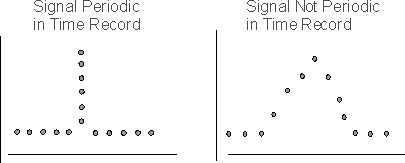Windowing
Windowing is useful when converting signals from the time domain into the frequency domain. The 89600 VSA uses the FFT (Fast Fourier Transform) to perform time-to-frequency domain transformations.
The FFT assumes that the signal it's processing is periodic from time record to time record. If the signal is not periodic in the time record, the FFT won't estimate the frequency components accurately. The result is called leakage, and it has the effect of spreading the energy from a single frequency across a range of frequencies, as shown below:

Windowing is the solution to the leakage problem. Multiplying the time record by a weighting function, or a window, forces the signal to be periodic in the time record. Windowing weights the data in the time domain to improve accuracy in the frequency domain.
FFT analyzers usually have several window types available. Each window offers particular advantages. Because each window type produces different measurement results (just how different depends on the characteristics of the input signal and how you trigger on it), you should carefully select a window type appropriate for the measurement you're trying to make.
See Also
